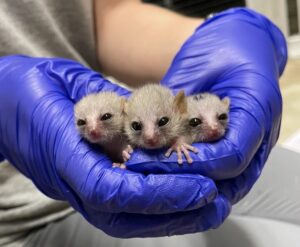
Monstera, Pothos, and Ficus are the first nocturnal infants of the 2024 season! When gray mouse lemur infants are under a month old, their caretakers will often mark their foreheads with colored dots to tell twins or triplets apart. Photo taken during the Day 9 infant weighing.
On May 29, 2024, experienced gray mouse lemur mother Fauna gave birth to triplets! For the second year in a row, Fauna surprised the DLC’s husbandry team with a third infant, despite ultrasounds that indicated twins. Ficus, one of the two boys, was born at a tiny 5.5 grams, while sister Monstera and brother Pothos were born at a more standard weight of just over 7 grams apiece.
Gray mouse lemurs are the smallest species housed at the Duke Lemur Center, with adults growing to only about three inches tall and weighing about as much as a stick of butter. The DLC houses one of the only gray mouse lemur breeding colonies in North America, and our mouse lemur colony consists of just under 50 individuals.
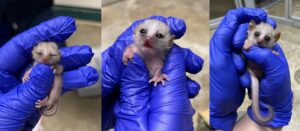
Monstera, the only female of the trio, is held gently by a member of the DLC’s husbandry staff during baby weighings at three, nine, and sixteen days old.
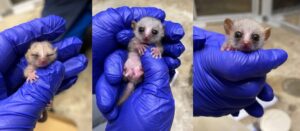
Pothos, the larger of the two males, held during infant weighings at three, nine, and thirteen days old.
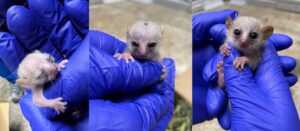
Ficus, the smallest of the trio, held during infant weighings at three, nine, and thirteen days old. The black dot on his head at Day 9 was marked by his caretaker to help differentiate him from his siblings.
Gray mouse lemurs at the DLC are named after plants, herbs, spices, and hot sauces. Husbandry staff will often choose a theme for a given litter; Fauna’s 2023 triplets, the “Toxic Trio,” were all named after toxic plants. This year, the family’s primary caretaker, Kathryn, named Fauna’s infants after common houseplants.
Unlike their namesakes, we do not recommend keeping mouse lemurs in your home! Despite their adorable appearance, gray mouse lemurs and other primates make terrible pets, and keeping a wild animal in your house is both dangerous and detrimental to that animal’s physical and mental wellbeing. If you’re interested in contributing to the care and conservation of mouse lemurs, you can symbolically adopt one through our Adopt a Lemur program! You will receive quarterly updates on your adoptee, who will continue to live at the Duke Lemur Center and be cared for by our trained professionals.
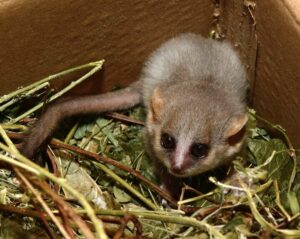
One-month-old Ficus sits inside a nest carefully constructed by his mother. Fauna is famous for building some of the most elaborate nests at the DLC for her infants! Photo by David Haring.

Ficus (top), Pothos (left), and Monstera (bottom) at one month old. Photo by David Haring.

